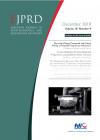European Journal of Prosthodontics and Restorative Dentistry

- Cover Date:
- December 2010
- Print ISSN:
- 0965-7452
- Vol:
- 18
- Issue:
- 4
Extrusion-Mixing Compared with Hand-Mixing of Polyether Impression Materials ?
Abstract - The hypotheses tested were two-fold (a) whether altering the base:catalyst ratio influences working time, elastic recovery and strain in compression properties of a hand-mixed polyether impression material and (b) whether an extrusion-mixed polyether impression material would have a significant advantage over a hand-mixed polyether impression material mixed to the optimum base:catalyst ratio. The polyether was hand-mixed at the optimum (manufacturers recommended) base:catalyst ratios (7:1) and further groups were made by increasing or decreasing the catalyst length by 25%. Additionally specimens were also made from an extrusion-mixed polyether impression material and compared with the optimum hand-mixed base:catalyst ratio. A penetrometer assembly was used to measure the working time (n=5). Five cylindrical specimens for each hand-mixed and extrusion mixed group investigated were employed for elastic recovery and strain in compression testing. Hand-mixing polyether impression materials with 25% more catalyst than that recommended significantly decreased the working time while hand-mixing with 25% less catalyst than that recommended significantly increased the strain in compression. The extrusion-mixed polyether impression material provided similar working time, elastic recovery and strain in compression to the hand-mixed polyether mixed at the optimum base:catalyst ratio.
KEY WORDS: base:catalyst ratio, polyether impression materials
- Article Price
- £15.00
- Institution Article Price
- £
- Page Start
- 150
- Page End
- 154
- Authors
- Caroline McMahon, Daniel Kinsella, Garry J.P. Fleming
Articles from this issue
- Title
- Pg. Start
- Pg. End
- The Relationship Between Fibre Post Geometry and Flexural Properties: An Assessment Through a Modified Three-Point Bending Test
- 158
- 162
- Repeatability of Electronic Shade Determination and the Influence of Differences in Patient’s Sitting Position.
- 171
- 175
- Surface Characteristic Changes of Dental Ceramics after Cyclic Immersion in Acidic Agents and Titratable Acidity
- 177
- 184
